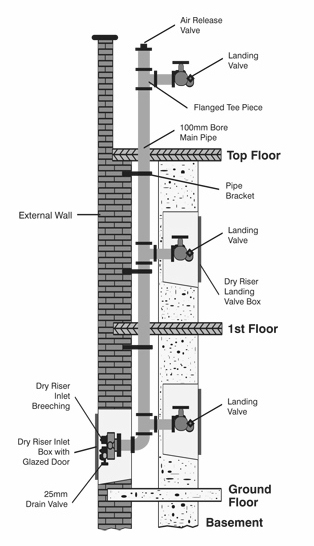 Required in buildings between 18m – 60m in height, a Dry Riser system is a vertical pipe fitted into staircase enclosures or other suitably convenient positions. Outlet Valves are situated on each level and an Inlet Valve fitted at ground level. Fire Fighters can route water from the nearest Fire Hydrant, through a high pressure pump and into the Dry Riser pipe; allowing them access to high pressure water in the upper levels of high rise buildings in the event of a fire.
Required in buildings between 18m – 60m in height, a Dry Riser system is a vertical pipe fitted into staircase enclosures or other suitably convenient positions. Outlet Valves are situated on each level and an Inlet Valve fitted at ground level. Fire Fighters can route water from the nearest Fire Hydrant, through a high pressure pump and into the Dry Riser pipe; allowing them access to high pressure water in the upper levels of high rise buildings in the event of a fire.
Dry Riser Systems can also be found in complexes which are spread over a large footprint ie: Shopping Malls or Train Stations. In this event the Dry Riser pipe covers the building over a largely horizontal extent and which is still governed by the same legal requirement for high pressure testing and maintenance.
As with most required safety systems there is a standard to which Dry Riser systems should be installed and maintained. The current British Standard which applies to Dry Riser Systems is BS9990:2006, which states that a Dry Riser system requires a full wet pressure test – to a pressure reading of ten bar – on an annual basis with a Test Certificate to be held on record and presented to the relevant authority during health and safety checks. Large fines will be administered where no valid certificate exists. Larger fines and prosecution have occurred when Dry Riser Systems are used in emergency situations and found to be inoperable.
BS9990/2006 requires that Dry Riser pipes must be water tight with all valves operating ready for immediate and un-impended use in an emergency. The Standard also recommends that the Dry Riser system be given a 6 monthly visual inspection.
The responsibility to ensure that the Dry Riser system test is carried out on an annual basis lies with the owner of the premises or, subsequently, with an acting Property Manager. If you are the property manager then you’ll know that you will be held fully responsible in the event of a Dry Riser System failing in an emergency situation or where a valid Test Certificate is non existent. You as the property manager could be fined directly or even prosecuted for failure to comply with the current British Standards regulation BS9990:2006.
Insurance companies have also indicated that Building Insurance may be invalid where a valid Test Certificate does not exist.
